Salmon Bake is a delicious pasta-free casserole that combines seafood and vegetables in a luscious white sauce for a hearty yet low-carb meal option your whole family will love.
This method of cooking is similar to my potatoes au gratin and is cheesy, low-carb, and made without pasta. It is an all-in-one dish that is done in just 45 minutes.

Made of flaky salmon cubes and crisp-tender cauliflower florets in a herb-infused creamy cheese sauce baked until gooey and golden!
Jump To
Why It's Yummy
- An easy seafood casserole recipe. You can make the cheese sauce while the cauliflower florets are in the pot. It will only take you 15 minutes to have everything in the casserole ready for the oven!
- A healthy, low-carb dish.
- Amazing flavors. The combination of buttery tender salmon, nutty cauliflowers, and a luxurious and indulgent cheese sauce. Everything is made from scratch and no need for canned soup.
Ingredients
- Cauliflower florets - I prefer using fresh but frozen florets will also work.
- Salmon filets - Use fresh salmon instead of frozen. You can also use canned tuna!
- Flour - use gluten-free flour blend if needed. Flour helps to thicken the sauce and give it a better consistency.
- Parmesan - Use freshly grated parmesan from the block instead of pre-grated which have preservatives like potato starch and natamycin to prevent them from clumping.
- Milk - you can use full fat or low fat, whatever you prefer.
- Heavy cream - with at least 35% fat. This is the key to making your roux rich and creamy.
- Lemon juice - will brighten the sauce with its fresh zesty taste.
- Dill - we used fresh chopped dill to give the dish a fresh, citrus-like taste.
- Nutmeg - adds a nutty, sweet, and woody flavor.

The full recipe and ingredients can be found in the recipe card below this post.
How To Make Baked Salmon Casserole
STEP 1: Preheat your oven to 400°F (200°C).
Grease a baking dish with a capacity of 1 to 1.5 liters (1.5-2-quart casserole dish) using butter or oil.

STEP 2: Boil water in a pot, cook cauliflower florets for 4-5 minutes on medium-low heat, and then drain. Set aside.
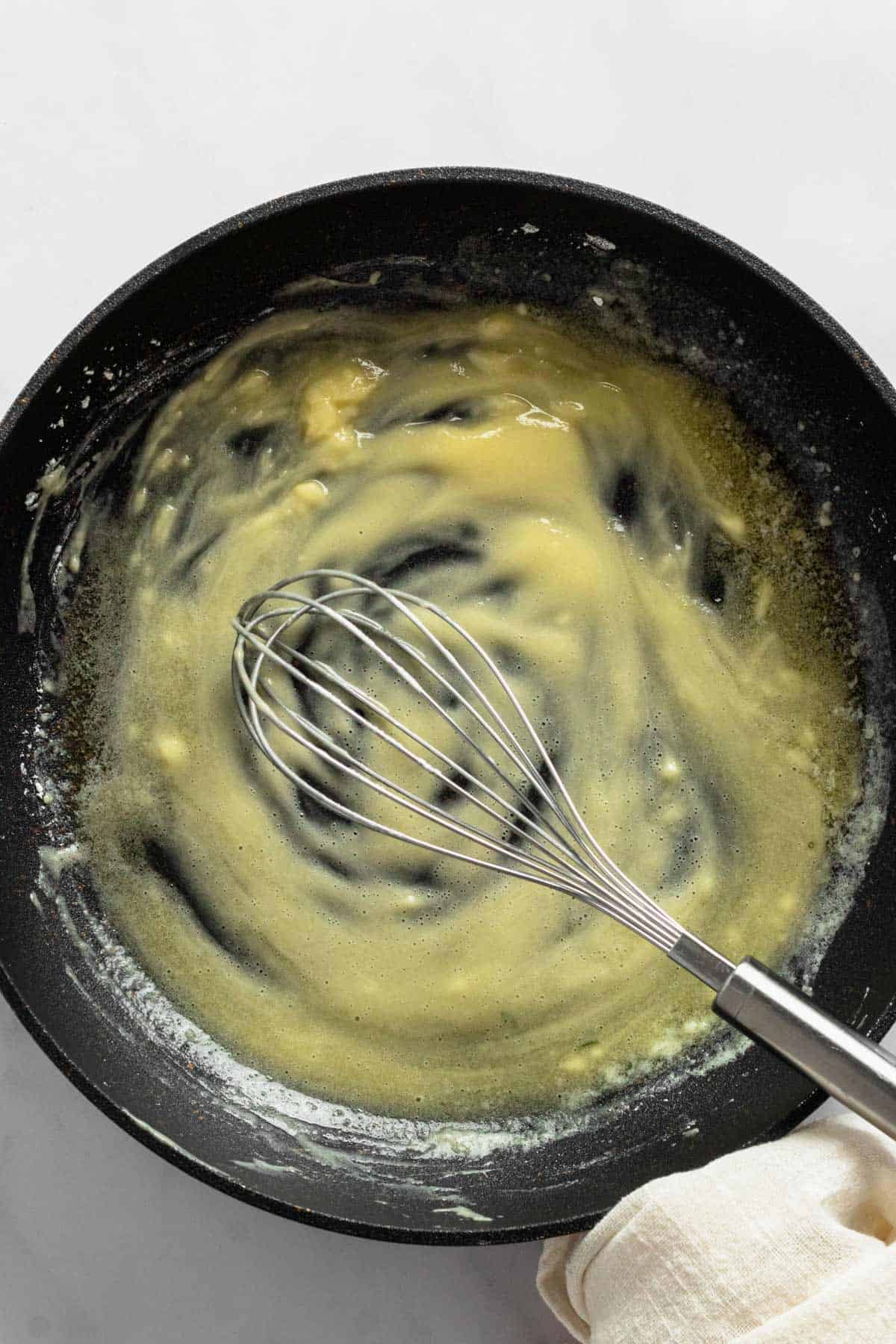
STEP 3: Make the roux. Melt butter in a skillet, add flour, whisk together.
Gradually stir in milk and heavy cream in batches, creating a roux.

Ensure a smooth, lump-free mixture. Season the roux with salt, black pepper, and nutmeg.
Mix well, add lemon juice, and whisk until thickened.

STEP 4: Make the cheese sauce. Take the roux off heat, stir in Parmesan cheese and dill, ensuring complete incorporation into the sauce.
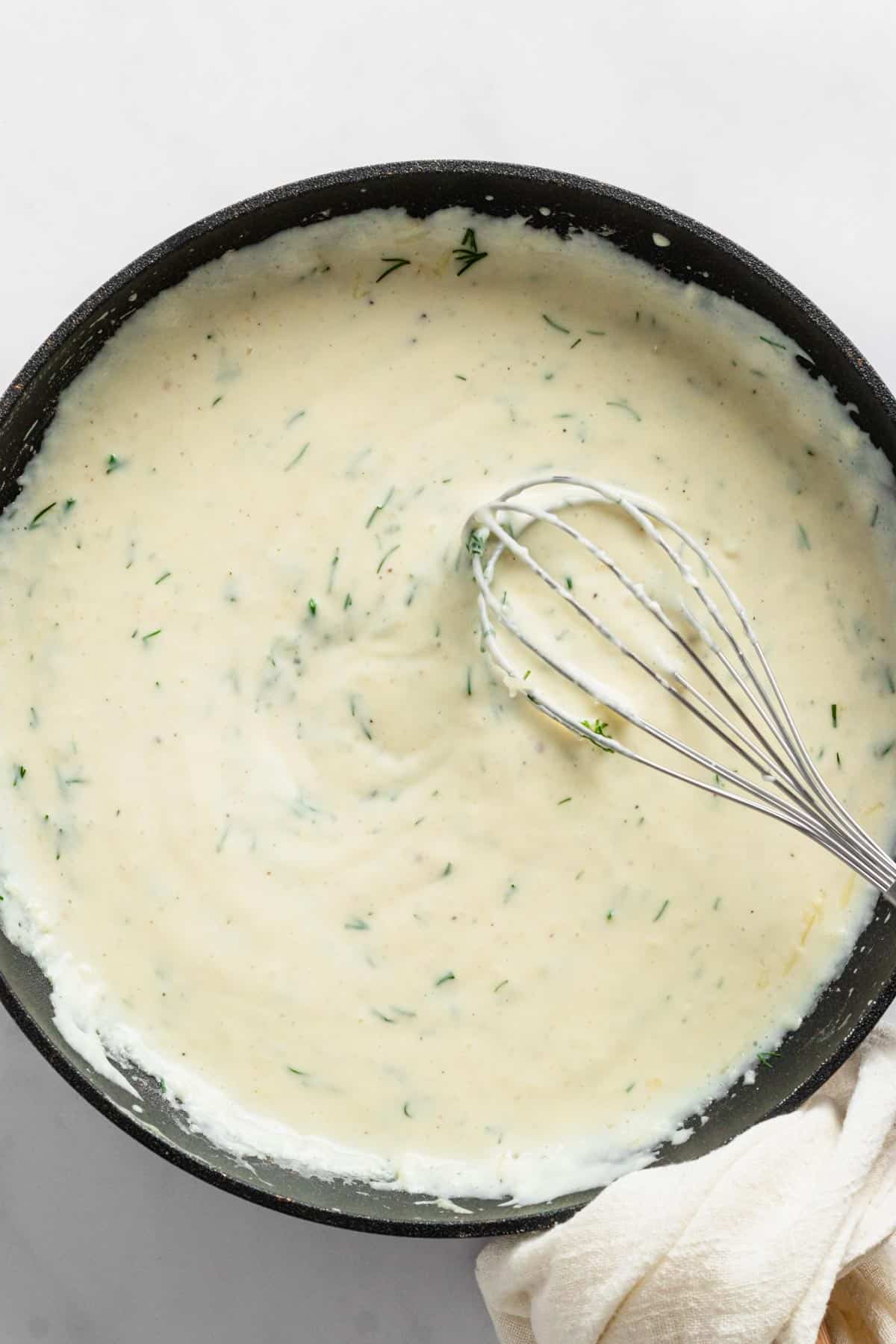
STEP 5: Assemble. Pour ¼ cup of the sauce into the base of the dish.
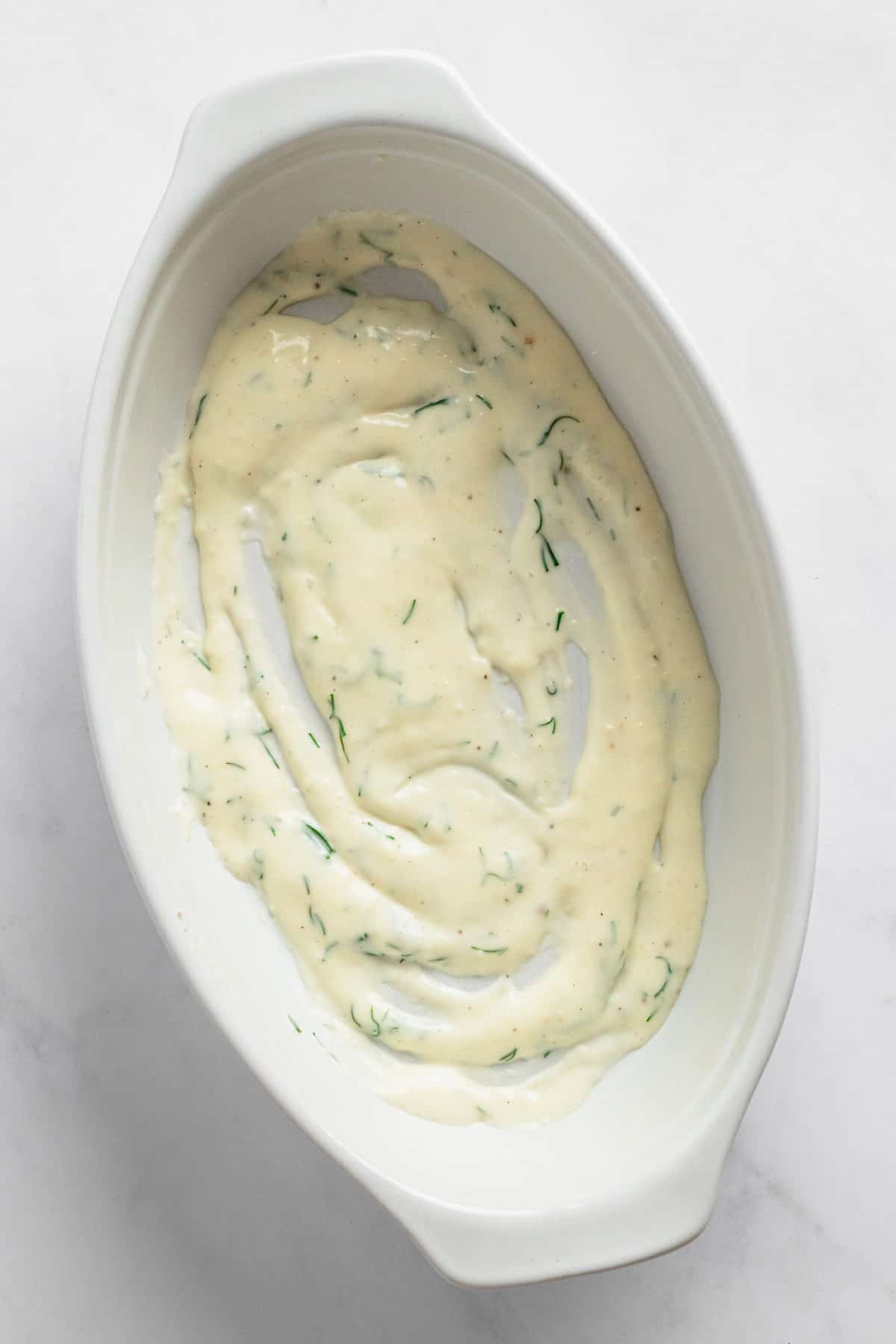
Arrange the cauliflower florets and salmon cubes in the dish.
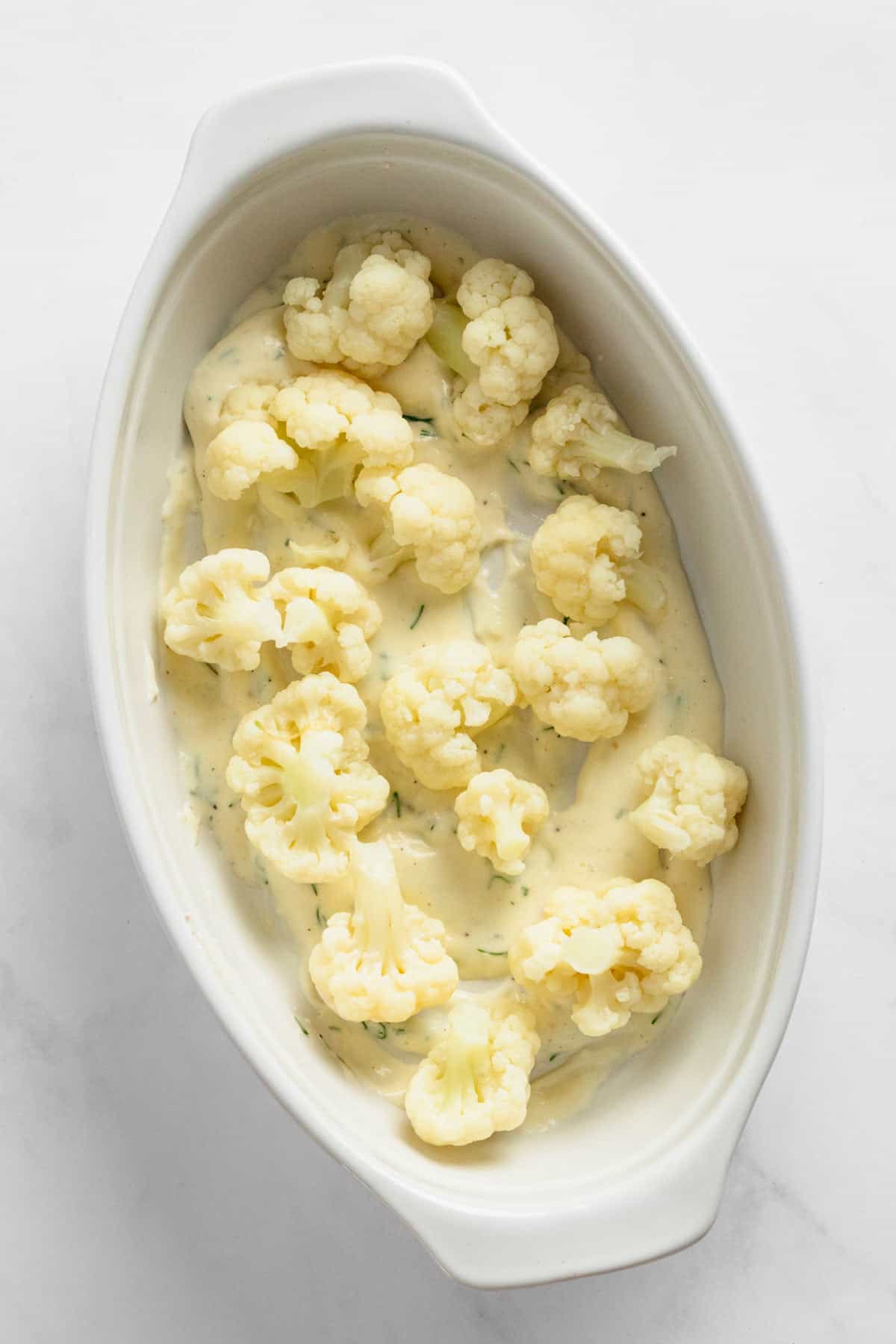
Pour the remaining sauce over the cauliflower and salmon.

STEP 6: Bake. Bake for 30 minutes until the top turns golden brown.
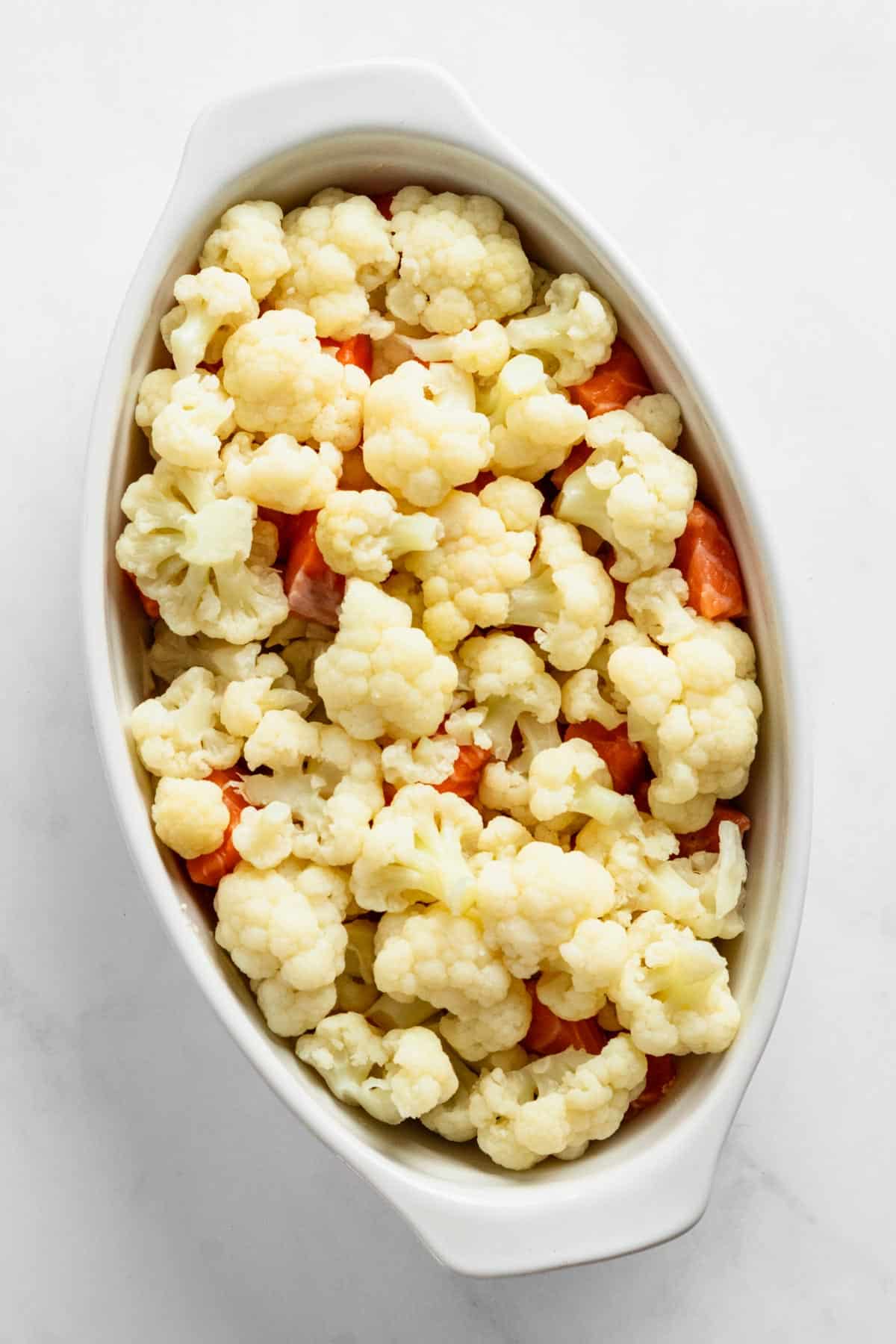
If the top begins to brown too much, cover the dish with foil.
Once done, serve and enjoy your meal.
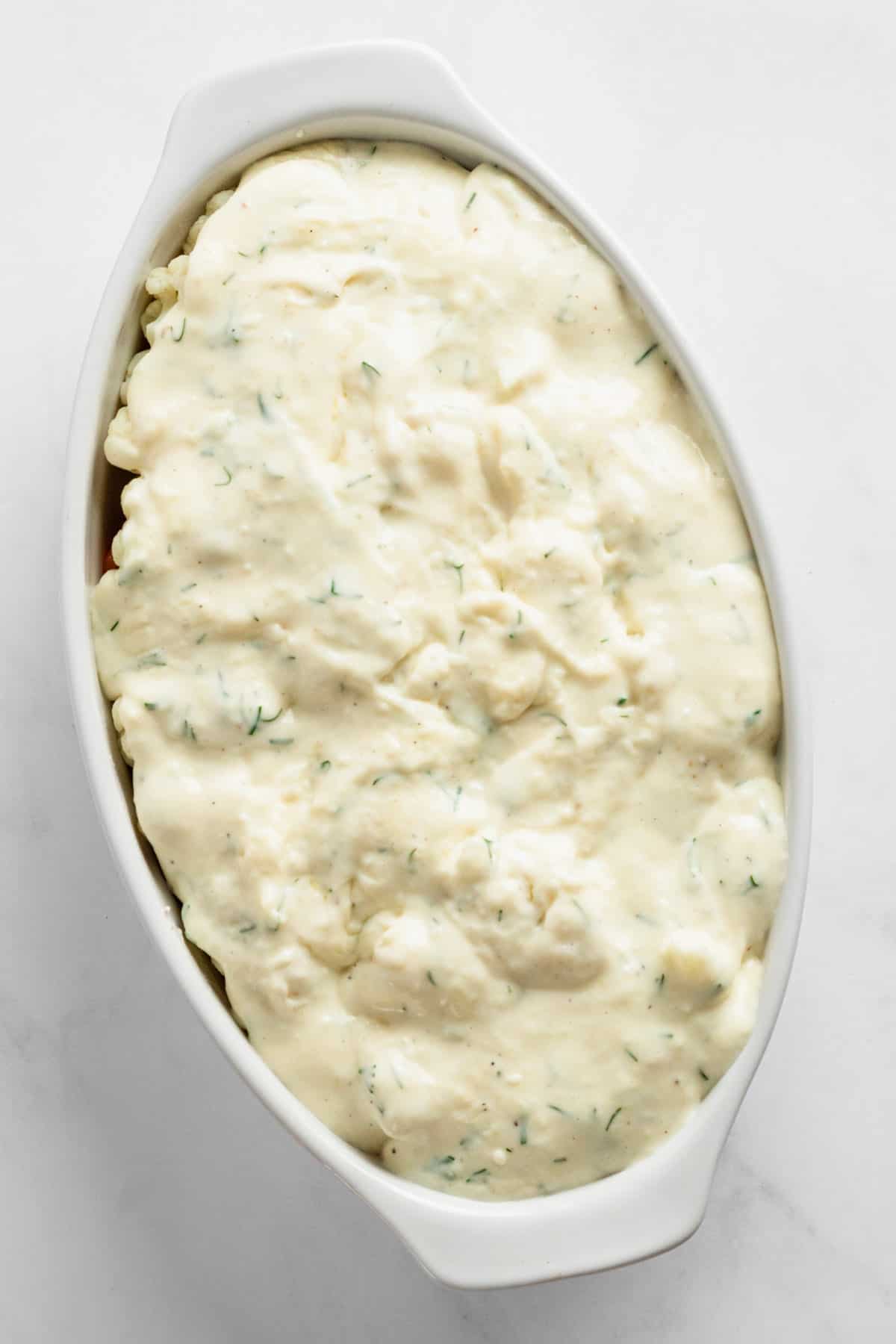
- OPTIONAL TOPPING: You can also add a crunchy topping with crushed crackers or cornflakes just like I did with my ham and potato casserole or million dollar chicken casserole.
Recipe Troubleshoot
Why are the cauliflower florets soggy instead of crisp-tender?
- They are overcooked. When cauliflower is boiled too long, it becomes mushy and loses its crisp texture. Just cook until they are a bit tender but still crisp.
- Using frozen florets. Frozen ones have more moisture than fresh. If using, ensure thorough thawing and draining before use.
- Not drying them. Cauliflower releases water when cooked. Drain and pat dry!
Why is my cheese sauce clumpy?
- Adding the cheese while the roux is cooking. Cheese contains proteins that can become overly tight and clump together when exposed to high heat. That is why we added it after removing the roux from heat.
- Using pre-shredded cheese. It often has anti-caking agents that may affect sauce smoothness. Freshly shredded cheese tends to be creamier.
- Not stirring constantly. Stir cheese sauce constantly for even distribution, preventing clumps; gradually incorporate for better blending.
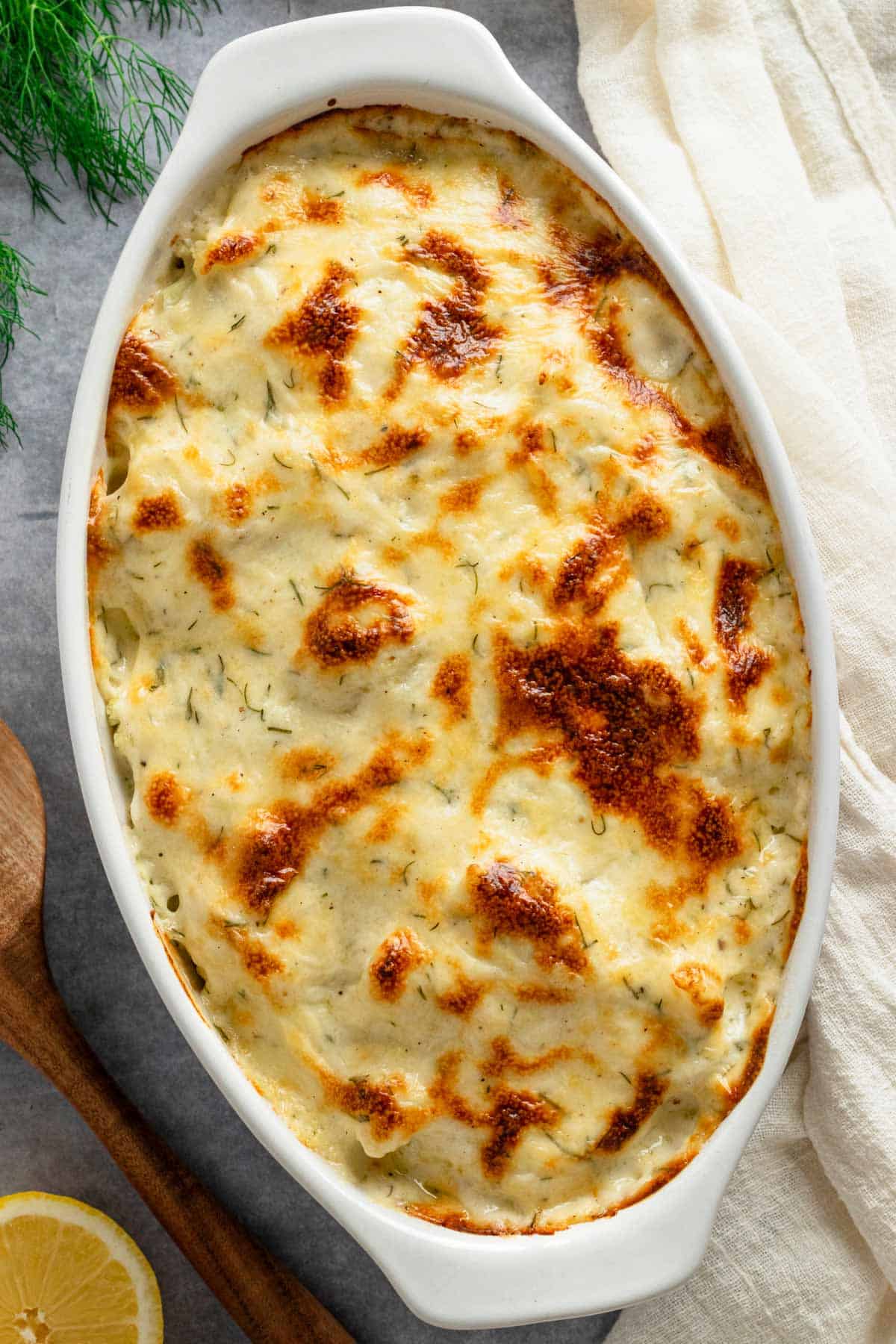
Tips
- Don't overcook the florets. Use a fork to pierce a floret to test its texture.
- Allow the baked salmon to rest briefly before serving to let the flavors meld.
- I don't recommend using canned salmon as this will affect the texture and quality of the dish. Use fresh salmon filets whenever possible.
What To Serve With Salmon Bake
- green salad
- cucumber salad
- sweet potatoes
- roasted veggies
- cornbread
- duchess potatoes
- mashed potatoes
- rice
Storing Leftovers
- To Store. Let the salmon gratin cool completely before storing. Place in a airtight container or cover the casserole with foil and store in the fridge for 2-3 days.
- To Freeze. Use airtight, freezer-safe containers or heavy-duty aluminum foil to wrap the casserole tightly. Do not keep it in the freezer for more than 2 to 3 months.
- To Reheat. If frozen, let it thaw in the fridge overnight. You can reheat using the microwave in short intervals or using the oven using a moderate temperature (around 350°F or 175°C).
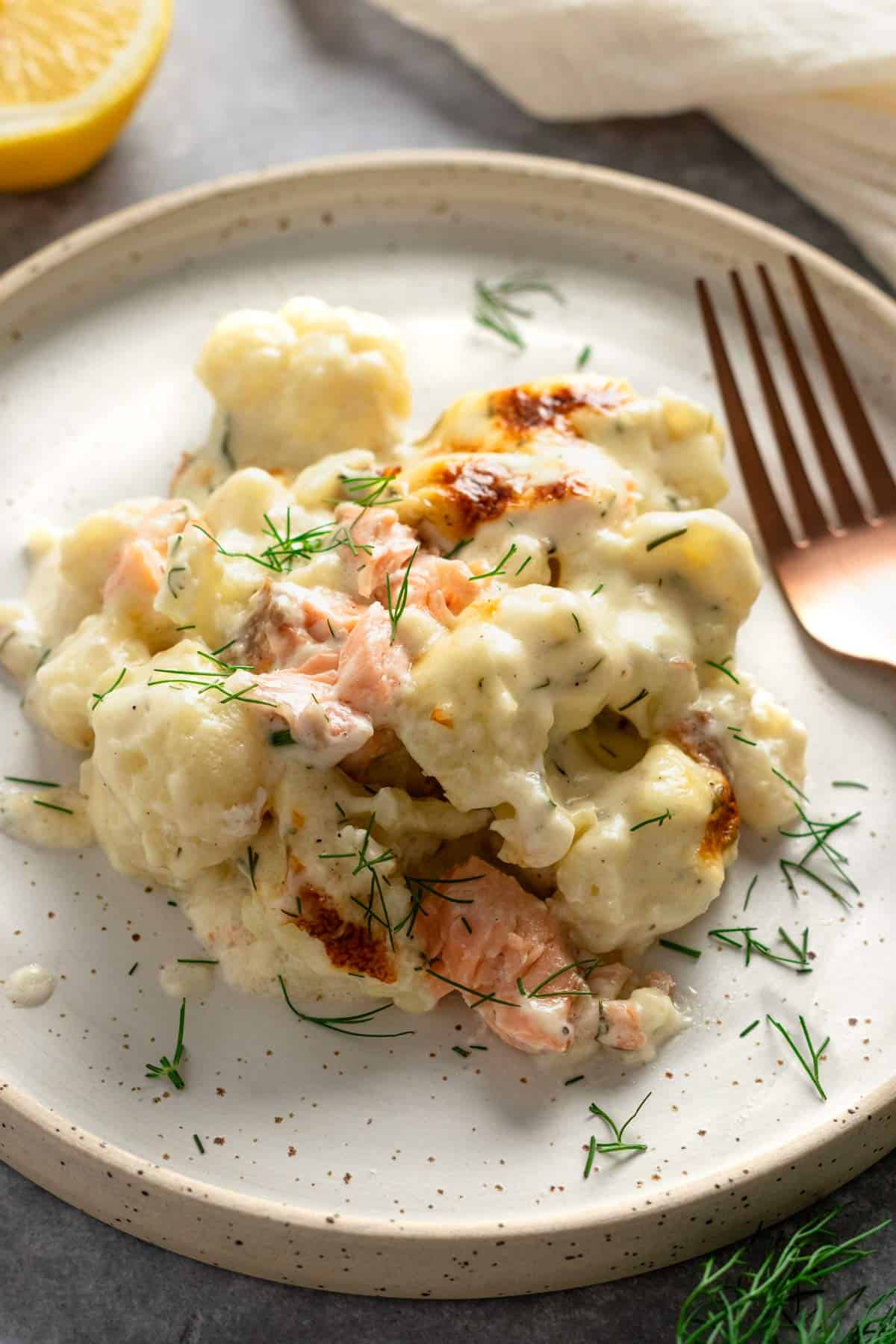
Substitutions and Variations
- Use other herbs and spices. Aside from nutmeg and dill, you can use fresh chives, thyme, rosemary, oregano, and some paprika.
- Make it spicy. Add some jalapenos, red chili flakes, hot sauce, or chili powder if you want to give the salmon bake a touch of heat.
- Cheese options. Aside from parmesan, other melty cheeses like mozzarella, Colby jack, cheddar cheese, Swiss, and Gruyère. You can also try a combination of these to give the cheese sauce more depth of flavor.
- Fresh Vegetables. Using other types of cruciferous veggies like broccoli and Brussels sprouts will work. You can also add more vegetables to boost the nutritional value of this recipe. Leeks, spinach, arugula, zucchini, and red bell pepper would be great!
- Instead of making the sauce from scratch, you can also use about 1-2 cups of cream of celery soup or cream of mushroom soup, or make this simple chicken soup that I've used in many recipes (Iess sodium or homemade if possible).
I would appreciate it so much if you left a comment about this recipe below! Subscribe to join the TYB newsletter and receive free recipes straight to your inbox! Let's connect via Facebook, IG & Pinterest!
Recipe

Salmon Bake
INGREDIENTS
- 1 pound cauliflower florets
- 8 ounce salmon fillet, diced into 1 inch cubes
- 3 tablespoons butter
- 3-4 tablespoons flour, use gluten free flour blend if needed
- ⅓ cup parmesan, grated
- 1 cup milk, full fat or low fat preferred
- 1 cup heavy cream, at least 35% fat
- 1 tablespoon lemon juice
- 1 tablespoon fresh dill, chopped
- A pinch of nutmeg
- kosher salt to taste
- black pepper to taste
INSTRUCTIONS
- Prep the oven and casserole. Preheat your oven to 400°F (200°C). Grease a baking dish with a capacity of 1 to 1.5 liters using butter or oil.
- Prepare the vegetables. Fill a pot with water and bring it to a boil. Add the cauliflower florets and simmer on medium-low heat for 4-5 minutes. Then, drain the cauliflower and set it aside.
- Make the roux. In a skillet, melt butter and add flour. Whisk them together. Gradually stir in the milk and heavy cream in batches, creating a roux while whisking.
- Ensure that the mixture becomes smooth and free of lumps. Season the roux with salt, black pepper, and nutmeg. Mix until well combined, and then add lemon juice. Whisk the roux until it thickens.
- Make the cheese sauce. Remove the roux from the heat and stir in Parmesan cheese and dill. Continue stirring until the cheese is fully incorporated into the sauce.
- Assemble. Pour ¼ cup of the sauce into the base of the dish. Arrange the cauliflower florets and salmon cubes in the dish. Pour the remaining sauce over the cauliflower and salmon.
- Bake. Bake in the preheated oven for 30 minutes. If the top begins to brown too much, cover the dish with foil. Once done, serve and enjoy your meal.
NOTES
- To Store. Let the salmon gratin cool completely before storing. Place in a lidded container or cover the casserole with foil and store in the fridge for 2-3 days.
- To Freeze. Use airtight, freezer-safe containers or heavy-duty aluminum foil to wrap the casserole tightly. Do not keep it in the freezer for more than 2 to 3 months.
- To Reheat. If frozen, let it thaw in the fridge overnight. You can reheat using the microwave in short intervals or using the oven using a moderate temperature (around 350°F or 175°C).
ADD YOUR OWN PRIVATE NOTES
NUTRITION
Note: Nutrition information is estimated and varies based on products used.
Full Nutrition Disclaimer can be found here.




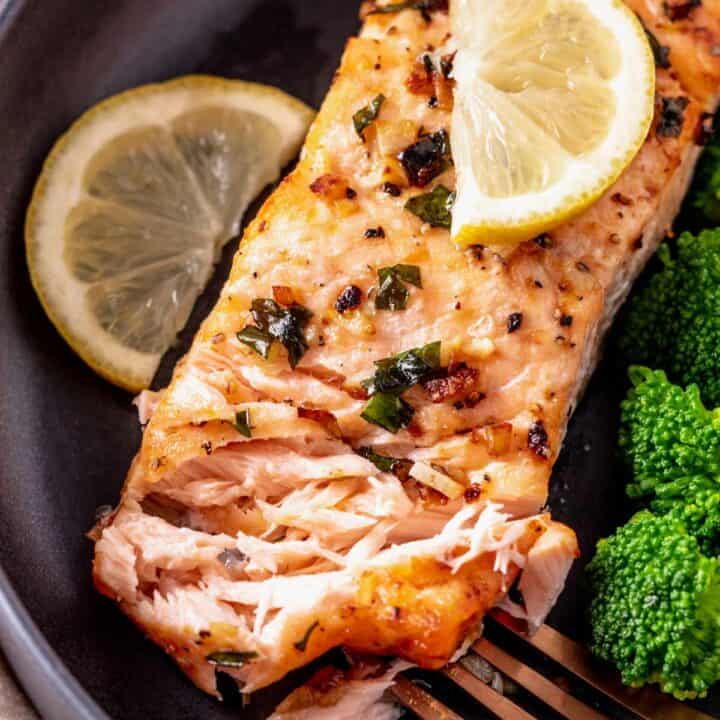


Julia | The Yummy Bowl
delicious way to enjoy fresh salmon with this creamy veggie casserole!